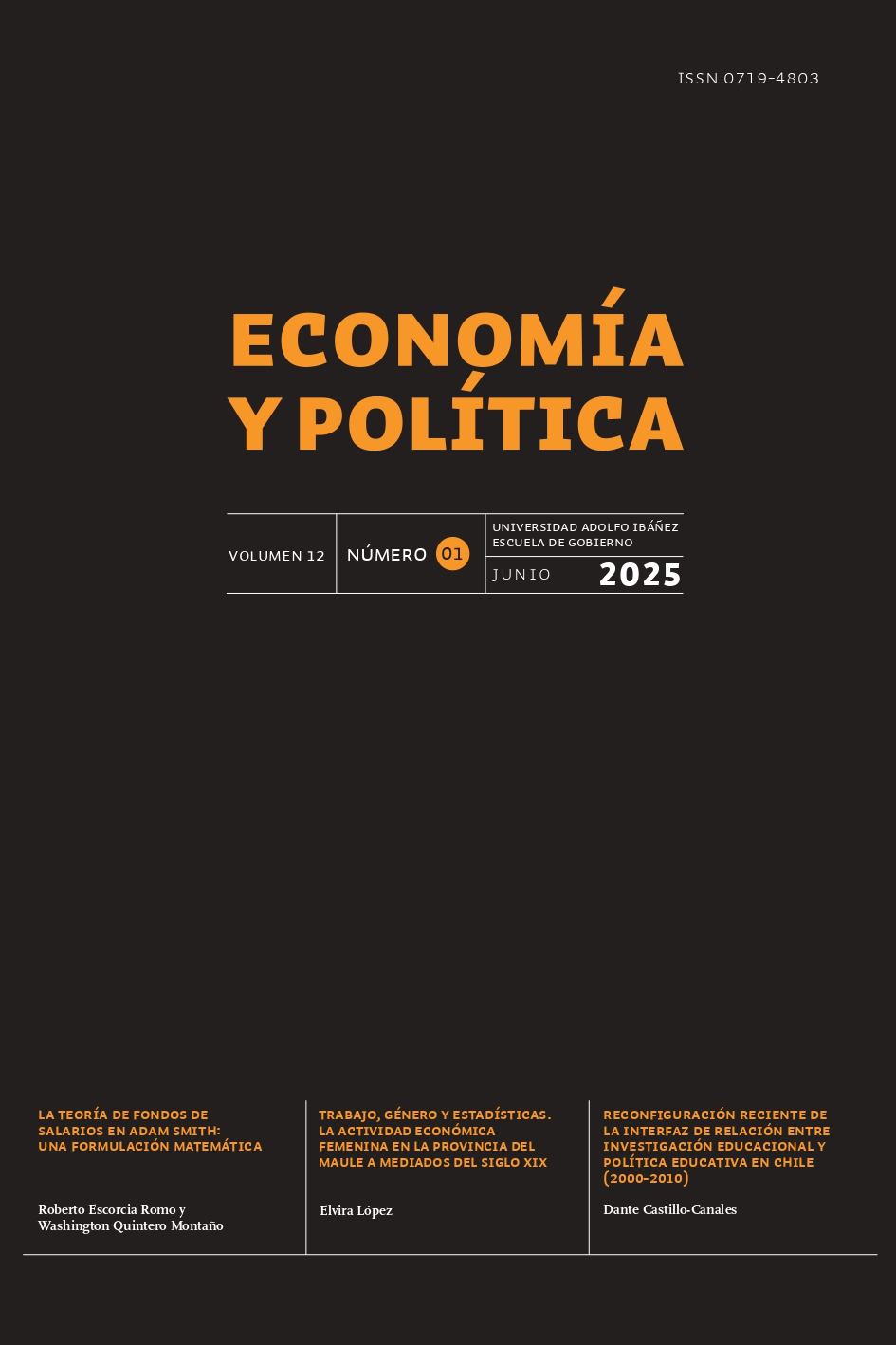Work, Gender, and Statistics: Women's Economic Activity in the Province of Maule in the Mid-Nineteenth Century
DOI:
https://doi.org/10.15691/07194714.2025.002Keywords:
female labor, 19th century Chile, gender biases, labor statistics, Maule provinceAbstract
This article reflects on female labor in Chile through the lens of statistics generated for a rural province, Maule, in the mid-19th century. It examines the dimensions of female labor and the early construction of categories to define it, as well as the distinctions made between productive activities and domestic work. The study also explores gender biases present in the sources from the period, which influenced the compilation of economic statistics and the visibility —or lack thereof— of these activities. The analysis illuminates a lesser-known phase of female labor integration and contributes to current debates by proposing an innovative intersection of perspectives that integrates economic history, labor history, and gender history.
References
Barros Arana, D. 1905-1906. Un decenio de la Historia de Chile (1841-1851), 2 tomos. Santiago: Imprenta y Encuadernación Universitaria.
Bauer, A. 1994. La sociedad rural chilena. Santiago: Editorial Universitaria.
Brito, A. 2005. Del rancho al conventillo. Transformaciones en la identidad popular femenina. Santiago de Chile, 1850-1920 (27-69), en S. Zárate y L. Godoy (eds.), Disciplina y desacato. Construcción de identidad en Chile, siglos XIX y XX. Santiago: Sur/Cedem.
Downs, L. L. 2002. L'Inégalité à la chaîne. La division sexuée du travail dans l'industrie métallurgique en France et en Angleterre. París: Albin Michel.
Escobar, B. y Llorca-Jaña, M. 2023. Liderazgo empresarial femenino en la historia económica de Chile. Santiago: Fondo de Cultura Económica.
Estefane, A. 2024. Contar. La producción de las primeras estadísticas oficiales en Chile. Santiago: DIBAM, Centro de Investigaciones Diego Barros Arana.
Gálvez, T. y Bravo, R. 1992. Siete décadas de registro del trabajo femenino, 1854-1920. Estadística & Economía (5), 1-52.
Gay, C. 1841. Questionnaires et réponses sur la situation des provinces du Chili adressées par Claude Gay aux Gouverneurs. Archives de la Société d'études archéologiques et scientifiques de Draguignan, Boite 1: Notes et documents divers, dossier vert, Mss 096/3/1 à 10. Draguignan, Francia.
Gay, C. 1862. Historia física y política de Chile. Agricultura, tomo I. París-Santiago: Casa del Autor, Museo de Historia Natural de Santiago.
Gay, C. 1865. Historia física y política de Chile. Agricultura, tomo II. París-Santiago: Casa del Autor, Museo de Historia Natural de Santiago.
Goldin, C. 1995. The U-Shaped Female Labor Force Function in Economic Development and Economic History (61-90), en P. Schultz, Investment in Women’s Human Capital and Economic Development. Chicago: University of Chicago Press.
Goldin, C. 2024. Nobel Lecture: An Evolving Economic Force. American Economic Review 114(6), 1515-1539.
Graham, M. 1902. Diario de mi residencia en Chile. Santiago: Imprenta Cervantes.
Guilbert, M. 1966. Les Fonctions des femmes dans l'industrie. Éditions Mouton.
Mac Ivor, J. 2001. A History of Work in Britain, 1880-1950. Basingstoke: Palgrave.
Maruani, M. y Meron, M. 2012. Un Siècle de travail des femmes en France, 1901-2011. París: La Découverte.
Memoria que el intendente del Maule presenta al señor ministro del Interior. 1864. Santiago, Imprenta Nacional.
Miditieri, G. y Pita, V. 2019. Trabajadoras, artesanos y mendigos. Una aproximación a las experiencias sociales de trabajo y pobreza en la Buenos Aires de la primera mitad del siglo XIX. Anuario del Instituto de Historia Argentina 19(1).
Mies, M. 2019. Patriarcado y acumulación a escala mundial. Madrid: Ediciones Cátedra.
Nari, M. 2002. El trabajo a domicilio y las obreras (1890-1918). Razón y Revolución (10), reedición electrónica.
Pita, V. y Gutiérrez, F. 2019. Entramados de historia social del trabajo en perspectiva de género: recorridos y desafíos historiográficos. Anuario del Instituto de Historia Argentina 19(1).
República de Chile. 1858. Censo jeneral de la República de Chile levantado en abril de 1854. Santiago: Imprenta del Ferrocarril.
Rotella, E. 1980. Women's Labor Force Participation and the Decline of the Family Economy in the United States. Explorations in Economic History 17(2), 95-117.
Sagredo, R., González, J. y Compan, J. 2017. La política en el espacio. Atlas histórico de las divisiones político-administrativas de Chile, 1810-1940. Santiago: Instituto Geográfico Militar, DIBAM, Centro de Investigaciones Diego Barros Arana, Pontificia Universidad Católica de Chile.
Salazar, G. 1985. Labradores, peones y proletarios. Santiago: Editorial Universitaria.
Salazar, G. y Pinto, J. 2002. Historia contemporánea de Chile. Tomo IV: Hombría y Feminidad. Santiago: Lom Ediciones.
Schultz, E. 1998. The Gendered Time of Waiting: Between the Dream and Action. Feminist Studies 24(1), 1-25.
Urizar Garfias, F. 1845. Estadística de la República de Chile. Provincia del Maule. Santiago: Imprenta de los Tribunales.
Vigna, X. y Zancarini-Fournel, M. 2013. Intersections entre histoire du genre et histoire ouvrière. Clio. Femmes, Genre, historie (38), 181-208.
Zárate, S. 2008. Dar a luz en Chile. Siglo XIX: De la “ciencia de hembra” a la ciencia obstétrica. Santiago: Ediciones de la Universidad Alberto Hurtado.
Zárate, S. y Godoy, L. 2005. Análisis crítico de los estudios históricos del trabajo femenino en Chile. Cuadernos de Investigación 2(2), 1-51.


